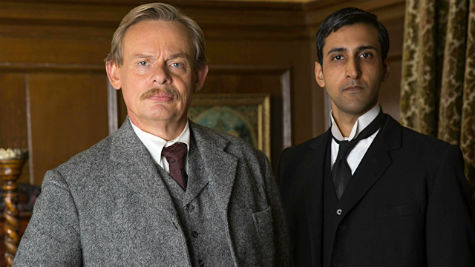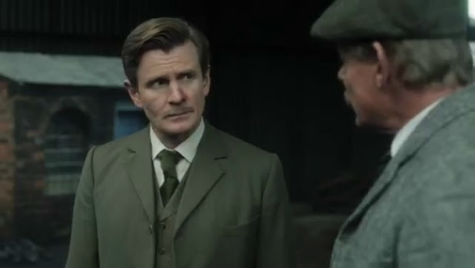
It’s one thing for a writer of detective fiction to dream up cases for his sleuth to solve. It’s quite another for that writer to be called upon to solve a case of his own.
Now imagine said writer was Sir Arthur Conan Doyle and said fictional detective Sherlock Holmes. How would the creator of the infallible Holmes fare when faced with a case of his own? What would be the damage to his reputation if it turns out he doesn’t share his creation’s intellect and skill for detection?
This is some of what’s at stake in Arthur & George, a three-part Masterpiece Mystery dramatization of the 2005 novel by Julian Barnes.
Martin Clunes, whom you might know best from the long-running series Doc Martin, stars as Sir Arthur Conan Doyle—the Arthur of the title.
Arsher Ali (he’ll turn up in the next series of Doctor Who) is George Edalji, a young solicitor who’s been convicted of a heinous crime.
Although he served his time, George maintains he’s innocent. To continue practicing law he must receive a pardon to clear his name. Arthur is convinced George is telling the truth and dedicates himself to righting this perceived miscarriage of justice. But can we trust Arthur’s judgment? Despite their obvious connection, Arthur Conan Doyle is not Sherlock Holmes.
Julian Barnes’s novel was based on real-life events that came to be known as the Great Wyrley Outrage. They involved the murder and dismemberment of livestock in the town of Great Wyrley, Staffordshire, in 1903.
Evidence in the case included unusually literate handwritten notes containing threats of violence and blackmail. The local police determined that the letters implicated George Edalji, the Anglo-Asian son of the town vicar. (Although the dramatization doesn’t make this clear, some of the real letters were signed in the name of George Edalji. Others mentioned him by name and implied that he was the leader of a “gang.”) Edalji served three years in Pentonville Prison for the crime.
In our story, Arthur decides immediately that George’s conviction was a cut-and-dried case of racism. “Race prejudice rather than hard evidence drove the police to the vicar’s son,” he tells his friend and secretary Alfred “Woodie” Wood, played by Charles Edwards (aka Edith’s beau Michael Gregson from Downton Abbey).

There’s reason for doubt, however. Woodie isn’t convinced of George’s innocence; and, frankly, neither are we in part 1 of this dramatization. Although a number of clues indicate that someone other than George is responsible for the crimes (who that person might be is a mystery), George isn’t a sympathetic character and his behavior can be downright odd. Maybe he’s a earnest young solicitor—the real George would have been in his mid-twenties at the time of the crimes—or maybe he’s a creepy animal torturer who’s about to “graduate from defenseless animals to defenseless children” as one of the more chilling letters indicates. We’ve all watched enough TV crime dramas to know he could go either way.
If Arthur is correct and George is innocent, why has he been targeted for persecution? George Edalji himself is adamant that his background as the son of an ethnically Parsee father is not the reason he and his family are being harassed. The fact that similar blackmail letters were sent to the village blacksmith would seem to bear this out, but…
But…but…but…
So many unanswered questions arise in part 1. Let’s start with why George Edalji seeks out Arthur Conan Doyle of all people to help prove his innocence. This seems an unusual strategy for a man seeking to clear his name, particularly when that man was a solicitor who, presumably, had plenty of connections in legal circles. George’s family insists he’s not seeking the limelight; why, then, call upon one of the most famous men in England to champion him?
Arthur & George, the novel, is a dense 500 pages or so. Dramatizing it as three 45-minute episodes was a challenge, and it shows. The teleplay becomes choppy as it attempts to cram in details about Doyle’s first marriage and his relationship with Jean Leckie, played by Hattie Morahan (from Series 2 of The Bletchley Circle) in full-on Emma Thompson mode. Then, defying reason, it becomes a romp with Doyle and Woodie doing their best Holmes and Watson impression, weighing the pros and cons of wearing false beards then chasing a hooded figure through a mist-covered garden at night.
Determining what Arthur & George, the TV mini-series, wants to be is almost as complicated as determining whether George Edalji is innocent or guilty. Perhaps part 2 will enlighten us further.
Leslie Gilbert Elman is the author of Weird But True: 200 Astounding, Outrageous, and Totally Off the Wall Facts. Follow her on Twitter @leslieelman.
Read all of Leslie Gilbert Elman’s posts for Criminal Element.
